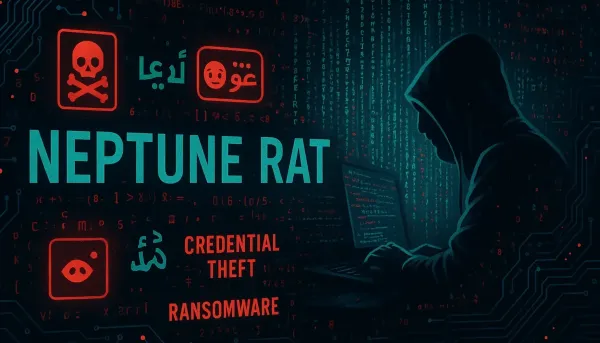
Understanding Neptune RAT- Cybersecurity Threats & Defense
In the ever-evolving landscape of cybersecurity threats, Remote Access Trojans (RATs) have emerged as particularly insidious tools that enable attackers to gain unauthorized access to victim machines. Recently, a variant of Neptune RAT has gained traction, notably disseminated through platforms such as GitHub, Telegram, and YouTube. Marketed as an advanced remote administration tool, it has drawn the attention of both novice cybercriminals and seasoned hackers. This blog post delves into the workings of Neptune RAT, its capabilities, dissemination methods, and actionable strategies for organizations to safeguard their systems.
What Is Neptune RAT?
Neptune RAT is a sophisticated malware primarily written in Visual Basic .NET, designed to exert control over Windows-based systems. Despite claims from its creator asserting that the software is intended for “educational and ethical purposes,” its functionalities reveal a starkly different reality. The malware is adept at exfiltrating user credentials, hijacking cryptocurrency transactions, and deploying ransomware functionalities—the completion of which showcases the product’s menacing potential.
Key Features of Neptune RAT:
- Credential Theft: Extracts sensitive user credentials from a multitude of applications, including browsers, email clients, and social media platforms.
- Ransomware Capabilities: Capable of encrypting files and demanding a ransom for decryption, significantly disrupting operations for victim organizations.
- Real-Time Monitoring: Enables live desktop monitoring, granting attackers insight into user activity.
- Evasion Techniques: Employs anti-analysis measures, registry modifications, and the use of PowerShell commands to obfuscate its presence and maintain persistence on infected machines.
- Infrastructure Agility: Can adjust its operation depending on the environment, including detecting virtual machines to evade sandbox analysis.
How Neptune RAT Spreads
Neptune RAT is primarily distributed via major social media platforms and collaborative coding sites. The creator deliberately obscures its executables to complicate analysis and hide its intent. The release of Neptune in its executable form allows for phishing schemes disguised as legitimate software, luring unsuspecting users.
Recent studies indicate that the RAT’s functionality can be enhanced by additional modules and DLLs, which may be dynamically downloaded from external sources. This pattern of operation exemplifies a living-off-the-land technique, leveraging existing system capabilities to execute unauthorized commands.
Obfuscation Techniques
A significant challenge in combating Neptune RAT lies in its adept use of obfuscation techniques. Recent observations have found that the malware replaces sections of its code with Arabic characters and emojis, making reverse engineering notably difficult. This tactic not only conceals malicious intent but also prolongs the time before detection by cybersecurity solutions.
Protecting Your System
Given the extensive capabilities of Neptune RAT, adopting a proactive and multi-layered security approach is imperative for both individuals and organizations. Here are several practical recommendations:
1. Incident Response and Training
- Conduct regular training sessions for employees on recognizing phishing attempts and suspicious software downloads.
- Establish an incident response protocol which includes steps to follow upon detecting suspicious activity.
2. Update and Patch Management
- Ensure operating systems and applications are up-to-date with the latest security patches, reducing the attack surface for potential exploits.
3. Implement Strong Access Controls
- Employ principles of least privilege across the organization to ensure that users only have access to the systems and information necessary for their roles.
4. Endpoint Security Solutions
- Utilize advanced endpoint detection and response (EDR) solutions that are capable of monitoring and analyzing PowerShell commands and other anomalous behavior.
- Regularly review alerts and logs generated by EDR systems to identify patterns indicative of RAT operations.
5. Threat Intelligence Integration
- Incorporate threat intelligence feeds to remain apprised of the latest indicators of compromise (IoCs) associated with Neptune RAT, adapting defenses accordingly.
Expert Insights and Analysis
Industry experts highlight the critical nature of Neptune RAT’s capabilities. Satish Swargam, Principal Security Consultant at Black Duck, emphasized the importance of continuous monitoring and strong endpoint defenses, particularly due to the RAT’s evolving features. As organizations increasingly utilize PowerShell and other legitimate administration tools, the need for vigilance against potential commoditized attacks, such as those exhibited by Neptune RAT, intensifies.
Darren Guccione, co-founder of Keeper Security, noted that Neptune RAT could pose severe disruptions, owing not only to its ability to lock files via ransomware but also due to its potential for real-time espionage.
Recent research indicates that similar RATs have been crafted, reflecting a broader trend in the malware landscape where free or “open-source” distributions of malicious software proliferate. Malicious actors can leverage these tools to initiate sophisticated cyber-espionage or financial crimes, significantly heightening the cybersecurity risk landscape.
Conclusion
The emergence of Neptune RAT serves as a stark reminder of the increasing threat posed by sophisticated malware in a digitally interconnected world. The accessibility of such malware, masked under the pretense of “educational purposes,” underscores a pressing need for enhanced cybersecurity vigilance. By adopting a rigorous approach to defense—centered around continuous monitoring, robust access controls, comprehensive training, and proactive threat detection—organizations can mitigate the risks associated with Neptune RAT and similar threats. As the landscape continues to evolve, commitment to cybersecurity best practices remains an imperative for safeguarding sensitive data and maintaining operational integrity.